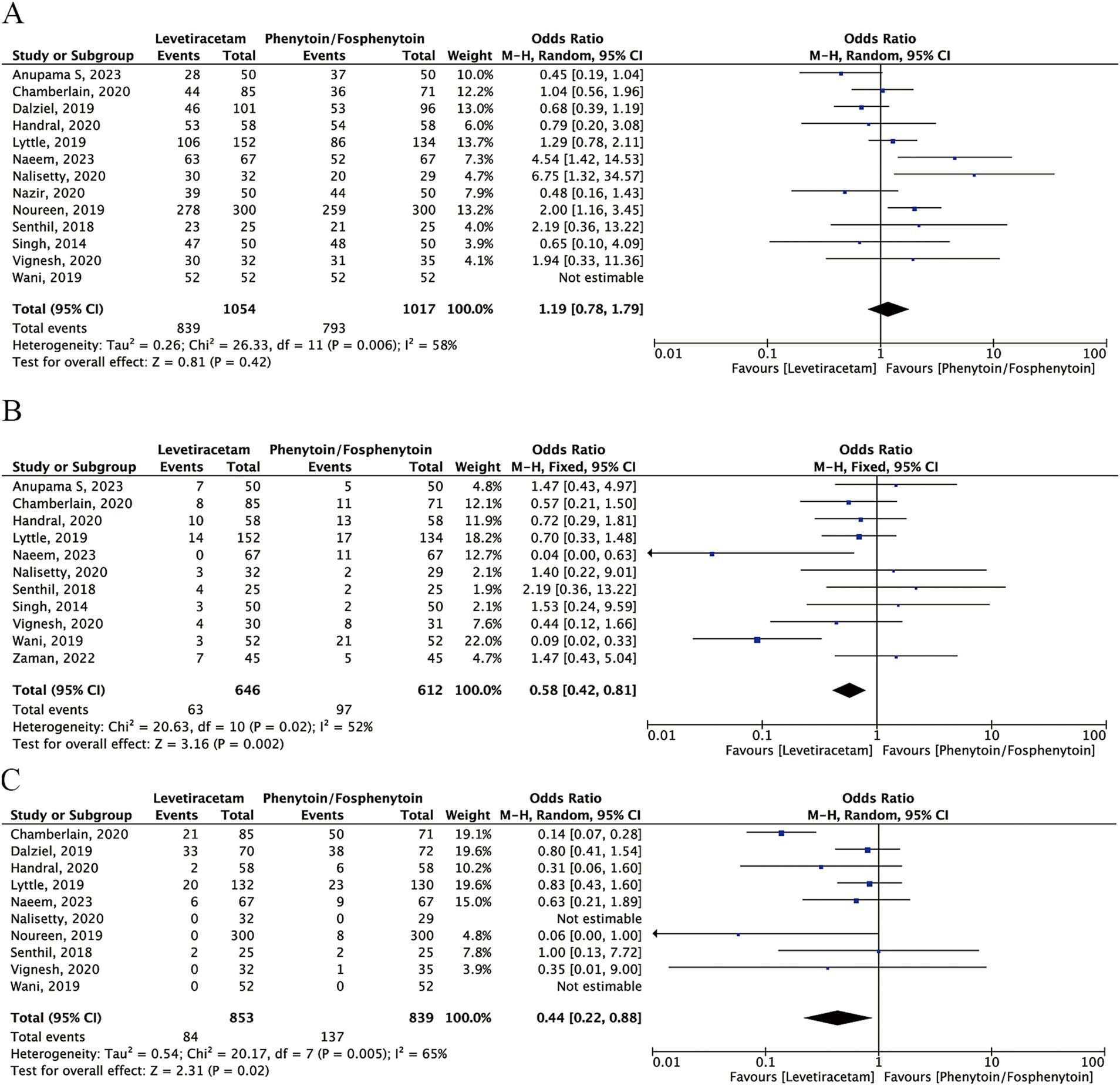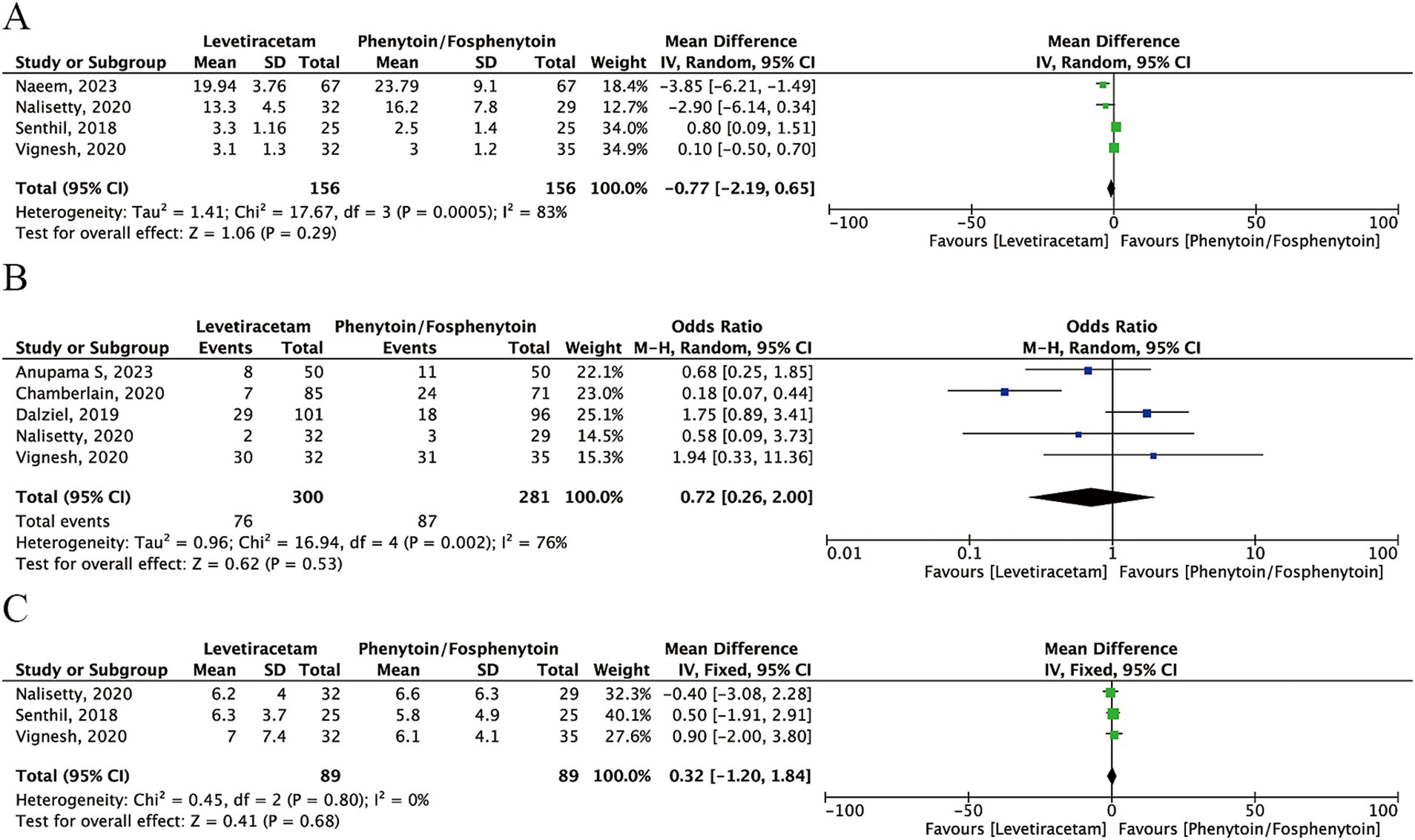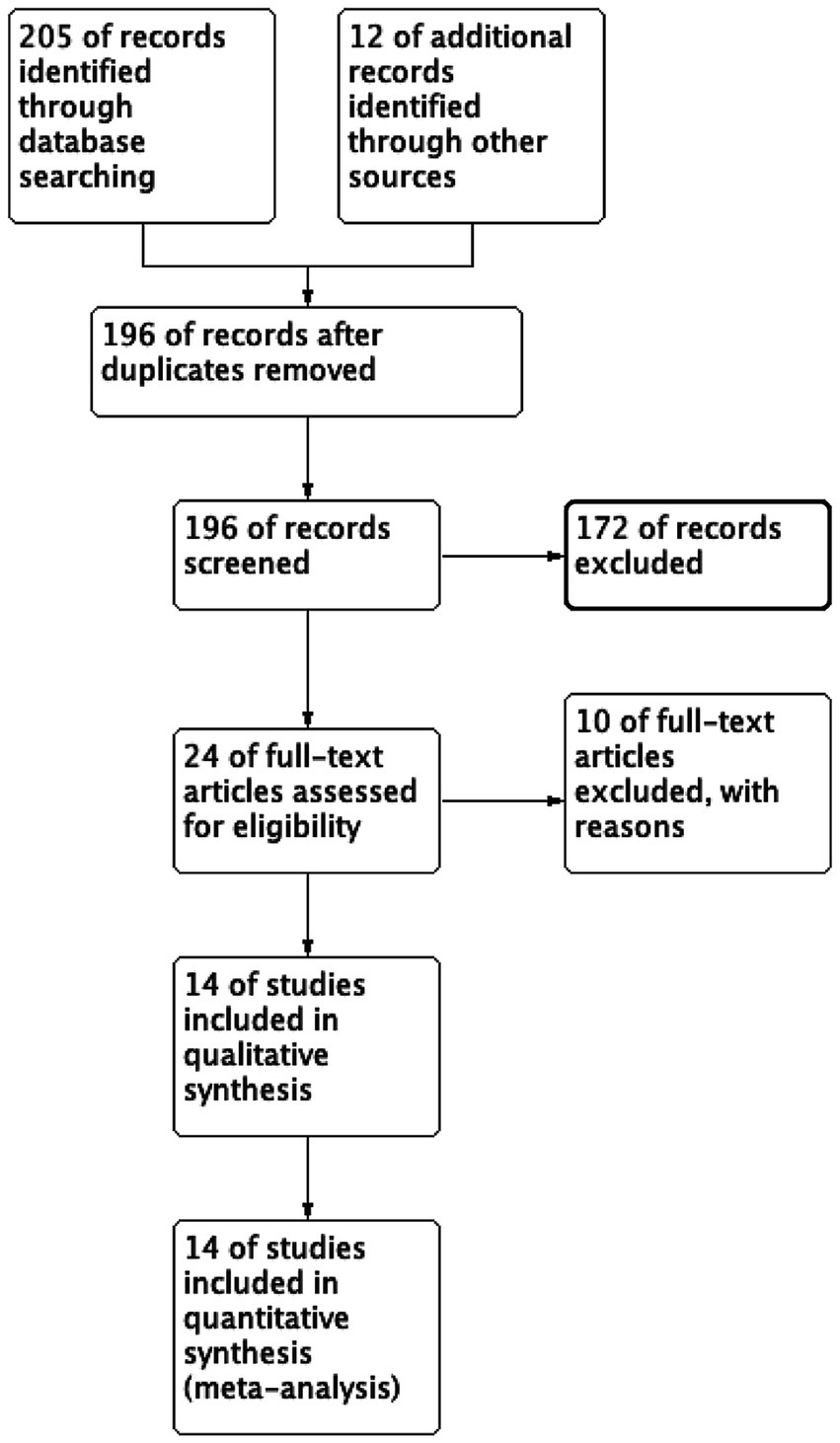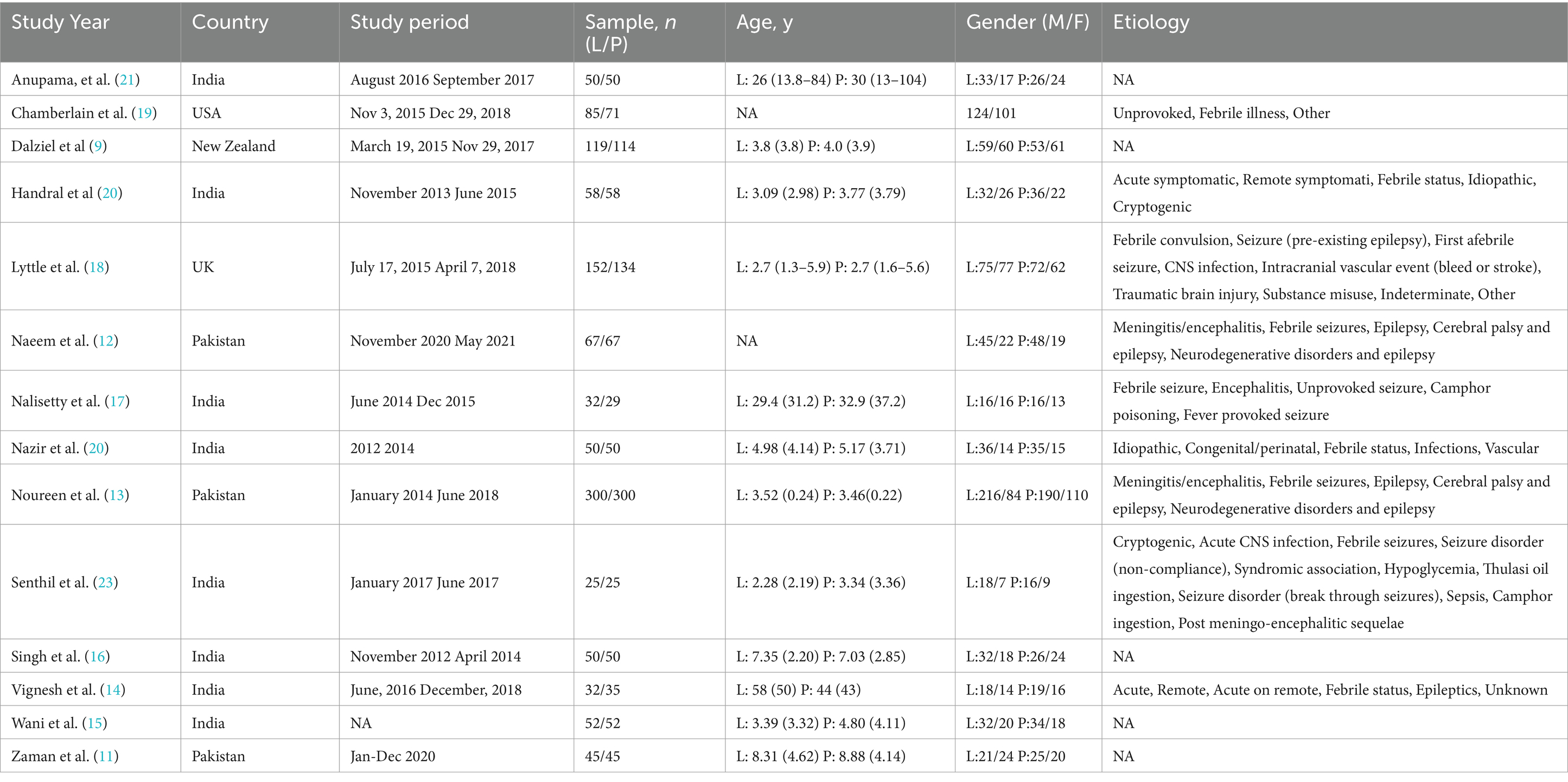- Department of Pediatric, Tianxiang Medical Oriental Hospital, Yiwu, China
Objective: To compare the efficacy and safety of levetiracetam versus phenytoin/fosphenytoin as second-line treatments in children with convulsive status epilepticus (CSE).
Methods: A systematic search identified randomized controlled trials comparing levetiracetam with phenytoin/fosphenytoin to treat CSE in children. Fourteen studies involving 2,197 patients were included in the meta-analysis.
Results: No significant difference was found between the two treatments regarding seizure cessation (odds ratio (OR): 1.18, 95% confidence interval (CI): 0.94–1.48; p = 0.16) or time to clinical seizure termination (mean difference: −0.10, 95% CI: −0.61 to 0.40; p = 0.69). However, levetiracetam was associated with significantly fewer seizure recurrences (OR: 0.60, 95% CI: 0.43–0.84; p = 0.003) and adverse events (OR: 0.59, 95% CI: 0.37–0.94; p = 0.03) compared with phenytoin/fosphenytoin. No significant differences were observed in the need for mechanical ventilation, intensive care unit admission, or hospital length of stay.
Conclusion: Levetiracetam is as effective as phenytoin/fosphenytoin to control seizures in children with CSE and is associated with fewer seizure recurrences and adverse events.
Background
Convulsive status epilepticus (CSE) is a serious neurological emergency in children that increases mortality and morbidity risks and has an incidence of 10–60 per 100,000 people. CSE requires prompt treatment and termination to obtain satisfactory outcomes (1, 2). Benzodiazepines are the first-line anticonvulsants for CSE; however, 35–60% of patients with CSE do not respond to this treatment (3, 4). Several conventional agents have been proposed as second-line treatment for children with CSE, including phenytoin and fosphenytoin (5); however, these drugs are associated with several adverse events. Levetiracetam was approved in 2006 for children and is a new anti-seizure medication. Recently, several studies demonstrated the safety and efficacy of levetiracetam when used to treat CSE (6, 7). Although levetiracetam has potent antiepileptic effects, there are potential side effects, including behavioral changes and sleep disturbances (8, 9). Various studies have compared phenytoin/fosphenytoin and levetiracetam in terms of safety and efficacy for second-line treatment of children with CSE; however, there is no clear evidence that confirms that one drug is superior to the other. We performed an up-to-date meta-analysis and systematic review of randomized controlled trials (RCTs) to compare the effectiveness of levetiracetam and phenytoin/fosphenytoin to treat pediatric cases of CSE.
Methods
This meta-analysis was performed in accordance with the Preferred Reporting Items for Systematic Reviews and Meta-Analysis (PRISMA) guidelines (10). Institutional Review Board approval was not applicable for this study.
Search strategy and selection criteria
Two authors independently performed a thorough electronic search of literature published before 1 January 2025 to identify original RCTs comparing levetiracetam and phenytoin/fosphenytoin treatment for children with CSE. We comprehensively searched the online databases of PubMed, Embase, Web of Science, the Cochrane Central Register of Controlled Trials (CENTRAL), and ClinicalTrials.gov. The English search terms included but were not limited to the following: “levetiracetam,” “phenytoin,” “fosphenytoin,” “epilepsy,” “seizures,” “convulsive status epilepticus,” and “antiepileptic.” The search was restricted to human subjects and English-language articles. We also manually reviewed the references of the articles identified in the initial search. Full-text articles and abstracts were included in this study. Retrospective studies, single-arm studies, review articles, case reports, editorials, and letters to the editor were excluded, as were duplicate publications by the same author or agency and studies with insufficient data for the outcome measures.
Outcome measures and data extraction
The primary outcome of this study was seizure cessation within 24 h. In most included studies, seizure cessation was defined based on clinical observation alone, while a few studies incorporated EEG-confirmed seizure cessation. Given this variability, we acknowledge this as a limitation and emphasize the need for standardized criteria in future studies. Secondary outcome measures were time to seizure recurrence within 24 h, termination of clinical seizure, adverse events, requirement for mechanical ventilation, intensive care unit admission, and hospital stays. Three authors independently extracted the following data from the included studies: authors, publication year, sample size, patient age, and etiology. Conflicts regarding data abstraction were resolved by consensus and by referring to the original article. EndNote version X8 (Thomson Reuters, Toronto, ON, Canada) was used to remove duplicate studies.
Assessment of methodological quality and risk of bias
Two authors independently evaluated the quality of the studies. The Cochrane collaboration tool (Center for Evidence-Based Medicine Odense and Cochrane Denmark, Denmark) was used to assess the quality of the RCTs by evaluating methods of randomization and allocation concealment, performance, and detection of bias.
Statistical analysis
All statistical analyses were performed using Review Manager version 5.3 software (Cochrane Informatics and Knowledge Management Department, Nordic Cochrane Center, Copenhagen, Denmark). Odds ratios (ORs) with 95% confidence intervals (CIs) were used to describe dichotomous outcomes. Publication bias was evaluated by the χ2 test and funnel plots. The I2 test and p-values were used to test heterogeneity, which was considered significant with I2 > 50% and p < 0.05. A fixed-effects model was used when heterogeneity was not significant; otherwise, a random-effects model was used. A two-tailed p-value < 0.05 was considered statistically significant. We also assessed the potential for publication bias through a visual inspection of funnel plot asymmetry.
Results
Study selection and trial characteristics
The search identified 217 articles, 21 of which were removed as duplicates; a further 172 were excluded after title and abstract review. Ten additional studies were excluded after applying the exclusion criteria. In total, 14 studies were included in the final meta-analysis (9, 11–23). The selection process and flow chart are summarized in Figure 1.
The 14 studies included RCTs involving 2,197 pediatric patients aged between 3 months and 16 years, who were enrolled into two groups (1,117 participants in the levetiracetam group and 1,080 participants in the phenytoin/fosphenytoin group). Among the 14 studies, 8 were performed in India, 3 in Pakistan, 1 in New Zealand, 1 in the USA, and 1 in the UK. All studies were published recently (2014–2023). The dose of levetiracetam varied from 20 to 60 mg/kg, while phenytoin/fosphenytoin was used at 20–30 mg/kg. The risk of bias is shown in Figure 2, and the characteristics of the included studies are shown in Table 1.

Figure 2. Consensus risk of bias assessment of the included studies. Green, low risk; yellow, unclear; red, high risk.
Primary outcomes
Seizure cessation
Data for seizure cessation were reported in all included trials, namely 839/1054 patients in the levetiracetam group and 793/1017 patients in the phenytoin/fosphenytoin group. There were no significant differences between the levetiracetam and phenytoin/fosphenytoin groups (OR: 1.19; 95% CI: 0.78–1.79), with I2 = 58% (Figure 3A).

Figure 3. Forest plot of the meta-analysis comparing levetiracetam and phenytoin/fosphenytoin. (A) Seizure cessation; (B) Seizure recurrence; (C) Adverse events.
Seizure recurrence
Eleven studies provided data for seizure recurrence for 63/646 patients in the levetiracetam group and 94/612 patients in the phenytoin/fosphenytoin group. Levetiracetam appeared to be associated with lower seizure recurrence rates compared with phenytoin/fosphenytoin (OR: 0.58; 95% CI: 0.42–0.81), with I2 = 52% (Figure 3B).
Adverse events
Ten studies reported 84/853 and 137/839 adverse events in the levetiracetam and phenytoin/fosphenytoin groups, respectively. Analysis showed that the levetiracetam group experienced fewer adverse events (OR: 0.59; 95% CI: 0.37–0.94), with I2 = 61% (Figure 3C).
Mechanical ventilation
Five studies reported the number of patients that required mechanical ventilation. Analysis revealed no significant difference between the levetiracetam and phenytoin/fosphenytoin groups (OR: 0.72; 95% CI: 0.26–2.00), with I2 = 76% (Figure 4A).

Figure 4. Forest plot of the meta-analysis comparing levetiracetam and phenytoin/fosphenytoin. (A) Mechanical ventilation; (B) Intensive care unit admission; (C) Hospital stays.
Intensive care unit admission
Six studies reported 222/469 patients in the levetiracetam group and 192/432 in the phenytoin/fosphenytoin group who required intensive care unit admission, with no significant difference between the groups (OR: 1.09; 95% CI: 0.68–1.76), with I2 = 39% (Figure 4B).
Hospital stays
Three studies reported data on hospital stays. The analysis revealed no significant difference between the levetiracetam and phenytoin/fosphenytoin groups (mean difference: 0.32, 95% CI: −1.20–1.84), with I2 = 0% (Figure 4C).
Sensitivity analysis and publication bias
The influence of a single study on the overall meta-analysis estimate was investigated by omitting one study at a time. The omission of any study resulted in no significant difference, indicating that our results were statistically reliable. Most graphical funnel plots of the parameters were symmetrical.
Discussion
In the present study, we compared the efficacy and safety of levetiracetam and phenytoin/fosphenytoin for second-line treatment of children with CSE. To our knowledge, this is the largest and most recent meta-analysis of RCTs on this topic to date. Our study showed that levetiracetam has comparable efficacy outcomes and is associated with fewer adverse events compared with phenytoin/fosphenytoin.
For children with CSE, numerous guidelines suggest benzodiazepines as the first-line anticonvulsant treatment (5). Several RCTs have compared levetiracetam and phenytoin/fosphenytoin for CSE treatment (9, 21, 24). A recent RCT showed that levetiracetam was comparable to fosphenytoin as a second-line medication for the management of CSE (21). Similar results have been confirmed in several studies (15, 18); however, this conclusion was not corroborated by others. The ConSEPT trial, an open-label, multicenter RCT, showed that levetiracetam was not superior to phenytoin (9). A different meta-analysis included retrospective studies and RCTs and demonstrated that levetiracetam was superior to phenytoin in children with CSE (1). Another meta-analysis included nine studies with a total of 1732 patients, and showed no significant difference between the two drugs in terms of seizure cessation (25). Compared with previous studies, the strength of the present study lies in its inclusion of the latest RCTs. The most recent study was published in 2023, while others were published within the last decade. Our study showed that levetiracetam was comparable with phenytoin/fosphenytoin; however, CSE remains a complex disease state with diverse presentations and underlying causes, and previous antiepileptic drug usage can affect treatment results. The included RCTs exhibited considerable variability in the definition of seizures and seizure recurrence. In future research, more high-quality, large-sample-size RCTs are needed.
Several adverse events have been reported with phenytoin/fosphenytoin use, including cardiac reactions, arrhythmia, hypotension, and skin manifestations (26). The adverse events of levetiracetam include behavioral changes, sleep disturbances, diplopia, and gastrointestinal manifestations, such as nausea. In our study, 10 RCTs reported data on adverse events, with 84/853 in the levetiracetam group and 137/839 in the phenytoin/fosphenytoin group, indicating that levetiracetam treatment led to fewer adverse events compared with phenytoin/fosphenytoin. However, some studies did not report adverse events, which could have led to selection bias. Additionally, the definition of adverse events varied between the RCTs. Although our study primarily focused on pediatric patients, we acknowledge that the adverse effects of phenytoin may be influenced by patient age and underlying conditions, such as infections. To address this, we have expanded the discussion to explore how these factors might contribute to the observed variations in adverse event rates. Additionally, we recommend that future studies stratify adverse effects based on patient age and comorbid conditions to provide a more comprehensive understanding of these potential interactions.
Although this study included the latest and largest known number of RCT studies, there were several limitations. Firstly, the limited number of studies for some secondary outcomes reduces the statistical power and generalizability of our findings. This limitation may have led to less precise effect estimates, and caution should be exercised when interpreting these results. Future large-scale, multicenter randomized controlled trials (RCTs) with adequate power are needed to confirm our findings and improve the robustness of the conclusions. Secondly, the definition of seizure cessation across included trials. While most studies relied on clinical observation to determine seizure cessation, a few incorporated EEG confirmation. The subjective nature of clinical assessment may have introduced variability in outcome reporting. Future trials should consider implementing standardized seizure cessation criteria, incorporating both clinical and EEG confirmation, to improve consistency and reliability. The studies included in this analysis also varied in terms of the drug dosage and study methods, mainly for levetiracetam (the dosage varied from 20 to 40 mg/kg). Infusion times also differed between studies. Thirdly, Some of the included studies did not report adverse events, which may have introduced selection bias in our safety analysis. The lack of standardized adverse event reporting could lead to an underestimation of the true incidence of side effects. This limitation highlights the need for future trials to adopt uniform safety reporting criteria to ensure a more accurate assessment of drug-related adverse events. Finally, the studies included in the analysis were predominantly conducted in India and Pakistan, which may introduce regional differences in drug availability, healthcare infrastructure, and prescribing practices. Additionally, population-specific genetic factors may influence treatment response, limiting the generalizability of our findings to other regions. Future research should aim to incorporate data from a broader range of geographic locations to enhance external validity.
Conclusion
In conclusion, our study showed that levetiracetam has comparable efficacy outcomes and is associated with fewer adverse events and seizure recurrence rates compared with phenytoin/fosphenytoin when used in the treatment of children with CSE.
Data availability statement
The original contributions presented in the study are included in the article/supplementary material, further inquiries can be directed to the corresponding author.
Author contributions
LJ: Writing – original draft, Writing – review & editing. ZJ: Data curation, Software, Writing – review & editing. ZW: Data curation, Writing – review & editing.
Funding
The author(s) declare that no financial support was received for the research and/or publication of this article.
Acknowledgments
We thank Jane Charbonneau, DVM, from Liwen Bianji (Edanz) (www.liwenbianji.cn) for editing the English text of a draft of this manuscript.
Conflict of interest
The authors declare that the research was conducted in the absence of any commercial or financial relationships that could be construed as a potential conflict of interest.
Generative AI statement
The author(s) declare that no Gen AI was used in the creation of this manuscript.
Publisher’s note
All claims expressed in this article are solely those of the authors and do not necessarily represent those of their affiliated organizations, or those of the publisher, the editors and the reviewers. Any product that may be evaluated in this article, or claim that may be made by its manufacturer, is not guaranteed or endorsed by the publisher.
Abbreviations
CSE, Convulsive status epilepticus; RCTs, Randomized controlled trials; OR, Odds ratio; CI, Confidence interval; CENTRAL, Cochrane Central Register of Controlled Trials; PRISMA, Preferred Reporting Items for Systematic Reviews and Meta-Analysis.
References
1. AlMuhanna, FA, AlMulihi, QA, AlMuhanna, MA, and AlSultan, EA. Comparison of safety and effectiveness between Levetiracetam and phenytoin in the treatment of pediatric status epilepticus: a meta-analysis. CNS Neurol Disord Drug Targets. (2023) 22:745–51. doi: 10.2174/1568007X04666220509215121
2. Colmard, M, Rivier, F, de Barry, G, Roubertie, A, Urtiaga-Valle, S, Mercedes-Alvarez, B, et al. Efficacy of intravenous clonazepam for paediatric convulsive status epilepticus. Dev Med Child Neurol. (2024) 66:1053–61. doi: 10.1111/dmcn.15859
3. Lewena, S, Pennington, V, Acworth, J, Thornton, S, Ngo, P, McIntyre, S, et al. Emergency Management of Pediatric Convulsive Status Epilepticus. Pediatr Emerg Care. (2009) 25:83–7. doi: 10.1097/PEC.0b013e318196ea6e
4. McTague, A, Martland, T, and Appleton, R. Drug management for acute tonic-clonic convulsions including convulsive status epilepticus in children. Cochrane Database Syst Rev. (2018) 2018:CD001905. doi: 10.1002/14651858.CD001905.pub3
5. Glauser, T, Shinnar, S, Gloss, D, Alldredge, B, Arya, R, Bainbridge, J, et al. Evidence-based guideline: treatment of convulsive status epilepticus in children and adults: report of the guideline Committee of the American Epilepsy Society. Epilepsy Curr. (2016) 16:48–61. doi: 10.5698/1535-7597-16.1.48
6. Dang, LT, and Silverstein, FS. Drug treatment of seizures and epilepsy in newborns and children. Pediatr Clin N Am. (2017) 64:1291–308. doi: 10.1016/j.pcl.2017.08.007
7. Schmidt, D, and Schachter, SC. Drug treatment of epilepsy in adults. BMJ. (2014) 348:g254–4. doi: 10.1136/bmj.g254
8. Wheless, JW, and Treiman, DM. The role of the newer antiepileptic drugs in the treatment of generalized convulsive status epilepticus. Epilepsia. (2008) 49:74–8. doi: 10.1111/j.1528-1167.2008.01929.x
9. Dalziel, SR, Borland, ML, Furyk, J, Bonisch, M, Neutze, J, Donath, S, et al. Levetiracetam versus phenytoin for second-line treatment of convulsive status epilepticus in children (ConSEPT): an open-label, multicentre, randomised controlled trial. Lancet. (2019) 393:2135–45. doi: 10.1016/S0140-6736(19)30722-6
10. Hutton, B, Salanti, G, Caldwell, DM, Chaimani, A, Schmid, CH, Cameron, C, et al. The PRISMA extension statement for reporting of systematic reviews incorporating network Meta-analyses of health care interventions: checklist and explanations. Ann Intern Med. (2015) 162:777–84. doi: 10.7326/M14-2385
11. Zaman, S, Shuaib, A, Shah, SA, Zahid, M, Khan, QUZ, and Murad, M. Outcome of intravenous Levetiracetam versus intravenous phenytoin in Management of Children with status epilepticus. Pak Armed Forces Med J. (2022) 72:779–82. doi: 10.51253/pafmj.v72i3.7651
12. Naeem, B, Ashfaq, M, and Qureshi, MA. Efficacy of levetiracetam versus phenytoin as a second-line antiepileptic drug in the management of benzodiazepine-refractory status epilepticus among children. J Ayub Med Coll Abbottabad. (2023) 35:410–4. doi: 10.55519/JAMC-03-11897
13. Noureen, N, Khan, S, Khursheed, A, Iqbal, I, Maryam, M, Sharib, SM, et al. Clinical efficacy and safety of injectable Levetiracetam versus phenytoin as second-line therapy in the Management of Generalized Convulsive Status Epilepticus in children: an open-label randomized controlled trial. J Clin Neurol. (2019) 15:468–72. doi: 10.3988/jcn.2019.15.4.468
14. Vignesh, V, Rameshkumar, R, and Mahadevan, S. Comparison of phenytoin, valproate and Levetiracetam in pediatric convulsive status epilepticus: a randomized double-blind controlled clinical trial. Indian Pediatr. (2020) 57:222–7. doi: 10.1007/s13312-020-1755-4
15. Imran, A, Wani, G, Dhawan, N, et al. Levetiracetam versus phenytoin in children with status epilepticus. J Fam Med Prim Care. (2019) 8:3367. doi: 10.4103/jfmpc.jfmpc_750_19
16. Singh, K, Aggarwal, A, Faridi, M, and Sharma, S. IV Levetiracetam versus IV phenytoin in childhood seizures: a randomized controlled trial. J Pediatr Neurosci. (2018) 13:158–64. doi: 10.4103/JPN.JPN_126_17
17. Nalisetty, S, Kandasamy, S, Sridharan, B, Vijayakumar, V, Sangaralingam, T, and Krishnamoorthi, N. Clinical effectiveness of Levetiracetam compared to Fosphenytoin in the treatment of Benzodiazepine Refractory convulsive status epilepticus. Indian J Pediatr. (2020) 87:512–9. doi: 10.1007/s12098-020-03221-2
18. Lyttle, MD, Rainford, NEA, Gamble, C, Messahel, S, Humphreys, A, Hickey, H, et al. Levetiracetam versus phenytoin for second-line treatment of paediatric convulsive status epilepticus (EcLiPSE): a multicentre, open-label, randomised trial. Lancet. (2019) 393:2125–34. doi: 10.1016/S0140-6736(19)30724-X
19. Chamberlain, JM, Kapur, J, Shinnar, S, Elm, J, Holsti, M, Babcock, L, et al. Efficacy of levetiracetam, fosphenytoin, and valproate for established status epilepticus by age group (ESETT): a double-blind, responsive-adaptive, randomised controlled trial. Lancet. (2020) 395:1217–24. doi: 10.1016/S0140-6736(20)30611-5
20. Nazir, M, Tarray, RA, Asimi, R, and Syed, WA. Comparative efficacy of IV phenytoin, IV valproate, and IV Levetiracetam in childhood status epilepticus. J Epilepsy Res. (2020) 10:69–73. doi: 10.14581/jer.20011
21. Anupama, S, Poovazhagi, V, Nisha, R, Suresh Kumar, S, and Sathya, J. Comparison of levetiracetam as second-line drug with fosphenytoin in convulsive status epilepticus among children: a single center, open-label randomized controlled trial. J Pediatr Crit Care. (2023) 10:18–23. doi: 10.4103/jpcc.jpcc_52_22
22. Handral, A, Veerappa, BG, Gowda, VK, Shivappa, SK, Benakappa, N, and Benakappa, A. Levetiracetam versus fosphenytoin in pediatric convulsive status epilepticus: a randomized controlled trial. J Pediatr Neurosci. (2020) 15:252–6. doi: 10.4103/jpn.JPN_109_19
23. Senthil, KCS, Selvakumar, P, and Kowsik, M. Randomized controlled trial of levetiracetam versus fosphenytoin for convulsive status epilepticus in children. Pediatr Rev Int J Pediatr Res. (2018) 5:237–42. doi: 10.17511/ijpr.2018.i04.13
24. Chakravarthi, S, Goyal, MK, Modi, M, Bhalla, A, and Singh, P. Levetiracetam versus phenytoin in management of status epilepticus. J Clin Neurosci. (2015) 22:959–63. doi: 10.1016/j.jocn.2014.12.013
25. DeMott, JM, Slocum, GW, Gottlieb, M, and Peksa, GD. Levetiracetam vs. phenytoin as 2nd-line treatment for status epilepticus: a systematic review and meta-analysis. Epilepsy Behav. (2020) 111:107286. doi: 10.1016/j.yebeh.2020.107286
Keywords: convulsive status epilepticus, phenytoin, fosphenytoin, levetiracetam, seizure, review, meta-analysis
Citation: Jin L, Jin Z and Wang Z (2025) Levetiracetam versus phenytoin/fosphenytoin for second-line treatment of children with convulsive status epilepticus: an up-to-date meta-analysis and systematic review of randomized controlled trials. Front. Neurol. 16:1580329. doi: 10.3389/fneur.2025.1580329
Edited by:
Jacopo Lanzone, San Raffaele Hospital (IRCCS), ItalyReviewed by:
Yotin Chinvarun, Phramongkutklao Hospital, ThailandNitish Chourasia, University of Tennessee Health Science Center (UTHSC), United States
Copyright © 2025 Jin, Jin and Wang. This is an open-access article distributed under the terms of the Creative Commons Attribution License (CC BY). The use, distribution or reproduction in other forums is permitted, provided the original author(s) and the copyright owner(s) are credited and that the original publication in this journal is cited, in accordance with accepted academic practice. No use, distribution or reproduction is permitted which does not comply with these terms.
*Correspondence: Linping Jin, amlubGlucGluZ0Bob3RtYWlsLmNvbQ==
 Linping Jin
Linping Jin Zhiping Jin
Zhiping Jin
